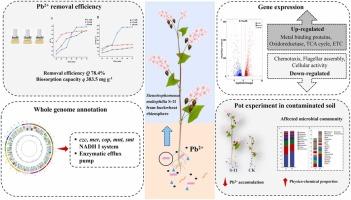嗜麦芽窄养单胞菌S-11的多组学分析揭示了其在污染土壤中修复Pb2+的潜力
IF 11.3
1区 环境科学与生态学
Q1 ENGINEERING, ENVIRONMENTAL
引用次数: 0
摘要
土壤中的铅(Pb 2 +)污染对环境构成重大威胁,但利用植物生长促进菌进行生物修复提供了一种可持续的解决方案。我们评估了从荞麦根际分离的嗜麦芽寡养单胞菌S-11的Pb 2 +解毒潜力。该菌株表现出较高的Pb 2⁺耐受性,最小抑制浓度为18 mM, Pb 2⁺在水介质中的去除效率为78.4% (Q),生物吸附量为383.5 mg g⁻¹。基因组分析确定了与Pb 2 +抗性相关的关键基因,包括与氧化应激反应和金属离子结合相关的基因。转录组学分析显示Pb 2 +胁迫下金属结合蛋白、细胞外聚合物质(EPS)、NADH氧化还原酶和膜转运蛋白上调,表明Pb 2 +具有双重解毒和隔离策略。在盆栽试验中,与未接种的对照相比,接种菌株S-11增加了荞麦生物量,减少了Pb 2 +在根和芽中的积累。菌株S-11成功定殖根际微生物群落,降低了污染土壤中Pb 2 +的生物有效性。研究结果表明,窄养单胞菌sp. S-11是一种很有前途的可持续Pb 2 +修复方法,为重金属胁迫缓解和土壤复殖提供了基因组学、酶学和结构方面的见解。该菌株采用协调的抗性策略,包括生物吸附、活性金属积累、电子传递链(ETC)重塑、金属封存和关键代谢途径的上调,以维持Pb 2 +胁迫下的能量和营养稳态。这种多方面的方法提高了Pb 2 +在污染下的存活率,并增强了其作为重金属污染环境中生物修复的有效生物接种剂的潜力。本文章由计算机程序翻译,如有差异,请以英文原文为准。

Multi-omics analysis of Stenotrophomonas maltophilia S-11 reveals its potential for Pb2+ bioremediation in contaminated soil
Lead (Pb²⁺) contamination in soil poses a significant environmental threat, but bioremediation using plant growth-promoting bacteria offers a sustainable solution. We evaluated the Pb²⁺ detoxification potential of Stenotrophomonas maltophilia strain S-11, isolated from the buckwheat rhizosphere. The strain exhibited high Pb²⁺ tolerance, with a minimum inhibitory concentration of 18 mM, along with a Pb²⁺ removal efficiency of 78.4 % (Q) and a biosorption capacity (q) of 383.5 mg g⁻¹ in aqueous media. Genomic analysis identified key genes involved in Pb²⁺ resistance, including those associated with oxidative stress responses and metal ion binding. Transcriptomic analysis revealed upregulation of metal-binding proteins, extracellular polymeric substances (EPS), NADH oxidoreductase, and membrane transporters under Pb²⁺ stress, indicating a dual detoxification and sequestration strategy. In a pot experiment, inoculation with strain S-11 increased buckwheat biomass and reduced Pb²⁺ accumulation in roots and shoots compared to the uninoculated control. Additionally, strain S-11 successfully colonized the rhizosphere microbial community and decreased bioavailable Pb²⁺ in contaminated soil. The findings demonstrate that Stenotrophomonas sp. S-11 is a promising candidate for sustainable Pb²⁺ remediation, providing genomic, enzymatic, and structural insights into heavy metal stress mitigation and soil reclamation. The strain employs a coordinated resistance strategy involving biosorption, active metal accumulation, electron transport chain (ETC) remodeling, metal sequestration, and upregulation of key metabolic pathways to maintain energy and nutrient homeostasis under Pb²⁺ stress. This multifaceted approach enhances its survival under Pb²⁺ contamination and strengthens its potential as an effective bioinoculant for bioremediation in heavy metal-contaminated environments.
求助全文
通过发布文献求助,成功后即可免费获取论文全文。
去求助
来源期刊

Journal of Hazardous Materials
工程技术-工程:环境
CiteScore
25.40
自引率
5.90%
发文量
3059
审稿时长
58 days
期刊介绍:
The Journal of Hazardous Materials serves as a global platform for promoting cutting-edge research in the field of Environmental Science and Engineering. Our publication features a wide range of articles, including full-length research papers, review articles, and perspectives, with the aim of enhancing our understanding of the dangers and risks associated with various materials concerning public health and the environment. It is important to note that the term "environmental contaminants" refers specifically to substances that pose hazardous effects through contamination, while excluding those that do not have such impacts on the environment or human health. Moreover, we emphasize the distinction between wastes and hazardous materials in order to provide further clarity on the scope of the journal. We have a keen interest in exploring specific compounds and microbial agents that have adverse effects on the environment.
 求助内容:
求助内容: 应助结果提醒方式:
应助结果提醒方式:


